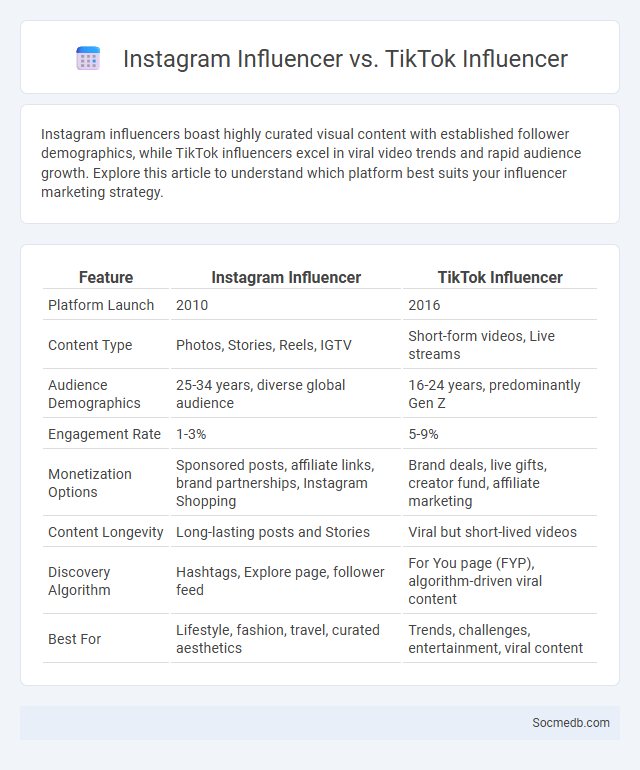
Photo illustration: Instagram Influencer vs TikTok Influencer
Instagram influencers boast highly curated visual content with established follower demographics, while TikTok influencers excel in viral video trends and rapid audience growth. Explore this article to understand which platform best suits your influencer marketing strategy.
Table of Comparison
| Feature | Instagram Influencer | TikTok Influencer |
|---|---|---|
| Platform Launch | 2010 | 2016 |
| Content Type | Photos, Stories, Reels, IGTV | Short-form videos, Live streams |
| Audience Demographics | 25-34 years, diverse global audience | 16-24 years, predominantly Gen Z |
| Engagement Rate | 1-3% | 5-9% |
| Monetization Options | Sponsored posts, affiliate links, brand partnerships, Instagram Shopping | Brand deals, live gifts, creator fund, affiliate marketing |
| Content Longevity | Long-lasting posts and Stories | Viral but short-lived videos |
| Discovery Algorithm | Hashtags, Explore page, follower feed | For You page (FYP), algorithm-driven viral content |
| Best For | Lifestyle, fashion, travel, curated aesthetics | Trends, challenges, entertainment, viral content |
Introduction: Defining Influencers Across Platforms
Influencers are individuals who create content and engage audiences across social media platforms such as Instagram, TikTok, YouTube, and Twitter, shaping trends and brand perceptions. These creators leverage their followers and authentic personas to impact purchasing decisions and cultural conversations. You can harness the power of influencers to amplify your brand's reach and credibility in targeted communities.
The Rise of Instagram Influencers
The rise of Instagram influencers has transformed social media marketing by leveraging authentic content and high engagement rates to connect brands with targeted audiences. Your brand can benefit from partnering with influencers who possess niche expertise and loyal follower bases, fostering trust and driving conversion rates. This shift emphasizes visual storytelling and user-generated content as powerful tools for expanding reach and enhancing brand credibility.
The TikTok Influencer Phenomenon
TikTok has revolutionized social media by creating a unique influencer ecosystem where creators gain rapid visibility through short, engaging videos. Your brand can leverage this phenomenon by partnering with TikTok influencers who possess authentic connections with diverse audiences, driving higher engagement and viral potential. Influencers on TikTok often shape trends and consumer behavior, making them crucial allies in digital marketing strategies.
Influencer: A Broad Overview
Influencers dominate social media platforms by creating engaging content that resonates with diverse audiences, driving brand awareness and consumer trust. Your marketing strategy can leverage influencer partnerships to enhance authenticity and reach targeted demographics more effectively. Data shows influencer marketing yields an average ROI of $6.50 for every $1 spent, highlighting its significance in digital campaigns.
Content Formats: Instagram vs TikTok vs General Influencers
Instagram excels with diverse content formats like Stories, Reels, and IGTV, allowing influencers to engage audiences through photos, short videos, and long-form content. TikTok emphasizes short, viral videos driven by music, trends, and creative editing, making it ideal for dynamic, fast-paced influencer campaigns. Your social media strategy should select platforms based on the preferred content format to maximize reach and engagement.
Audience Demographics and Reach Comparison
Social media platforms exhibit distinct audience demographics with Facebook dominating older age groups, while Instagram, TikTok, and Snapchat attract younger users aged 18-29. Audience reach varies significantly: Facebook boasts over 2.9 billion monthly active users, Instagram has approximately 2 billion, TikTok around 1 billion, and Snapchat about 600 million, highlighting diverse engagement levels. Marketers leverage these demographic insights to tailor campaigns effectively, optimizing reach and conversion rates across platforms.
Engagement Rates and Authenticity
High engagement rates on social media indicate your content resonates deeply with your audience, driving meaningful interactions such as likes, comments, and shares. Authenticity strengthens trust and loyalty, making your brand more relatable and encouraging genuine conversations. Prioritizing transparency and consistent messaging boosts both engagement rates and your overall social media presence.
Monetization Opportunities for Each Type
Social media platforms offer diverse monetization opportunities tailored to your content type and audience engagement. Influencers can leverage sponsored posts and brand partnerships on Instagram and TikTok, while YouTube creators earn through ad revenue and channel memberships. Facebook and LinkedIn enable businesses to generate leads and sales via targeted ads and subscription services, maximizing income streams across different social networks.
Brand Collaboration Strategies
Effective brand collaboration strategies on social media leverage influencer partnerships, co-branded content, and audience engagement to maximize reach and authenticity. Aligning your brand values with complementary partners enhances credibility, while data-driven targeting ensures campaigns resonate with your desired demographic. You boost brand visibility and trust by crafting authentic, mutually beneficial collaborations that drive conversions.
Choosing the Right Influencer Platform for Your Goals
Selecting the right influencer platform depends on your brand's target audience, campaign goals, and budget constraints. Platforms like Instagram excel in visual content and lifestyle niches, while YouTube suits long-form video promotion and tutorials. Analyze engagement rates, influencer authenticity, and platform demographics to maximize marketing ROI and ensure alignment with your brand values.
 socmedb.com
socmedb.com